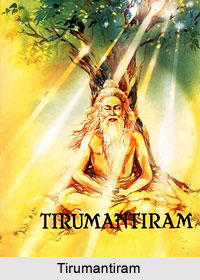 Tirumantiram or Tirumandhiram is a poetic work of devotional Tamil literature, composed by Tirumular in the 5th CE. Tirumantiram is the 10th of the 12 volumes of the Tirumurai, which is one of the main texts of Tamil Shaivism. Tirumantiram is the first known literary work in Tamil to use the word Shaiva Siddhanta and the oldest extant account of the Shaiva Agamas in Tamil. The poetic work comprises of three thousand verses which deals with different aspects of ethics, spirituality and praises of Lord Shiva. Tirumantiram is more spiritual than religious and is covers approximately every trait of the Tamil Siddha cult. The Tamil poetic work focuses on the fundamentals of Siddha medicine and its curative abilities. It also deals with various other themes like physical culture, astronomy and others.
Tirumantiram or Tirumandhiram is a poetic work of devotional Tamil literature, composed by Tirumular in the 5th CE. Tirumantiram is the 10th of the 12 volumes of the Tirumurai, which is one of the main texts of Tamil Shaivism. Tirumantiram is the first known literary work in Tamil to use the word Shaiva Siddhanta and the oldest extant account of the Shaiva Agamas in Tamil. The poetic work comprises of three thousand verses which deals with different aspects of ethics, spirituality and praises of Lord Shiva. Tirumantiram is more spiritual than religious and is covers approximately every trait of the Tamil Siddha cult. The Tamil poetic work focuses on the fundamentals of Siddha medicine and its curative abilities. It also deals with various other themes like physical culture, astronomy and others.
Content of Tirumantiram
Tirumantiram, which gives emphasis to the concept Love is God (Anbey Sivam), is classified into 9 tantirams or chapters. The first chapter consists of philosophical notions, divine understanding, impermanency of the physical existence, education, love etc. The second chapter deals with Lord Shiva`s glory and his divine actions, categorization of souls etc. The third chapter of Tirumantiram focuses of practices of Yoga according to the way of Patanjali. The fourth chapter deals with tantra and mantra. The fifth chapter of the poetic work focuses of the various aspects of the Shaiva religion and the elements of Shaiva Siddhanta. Tirumantiram, in its sixth chapter, portrays Shiva as a guru and the responsibility of the devotees. The seventh chapter describes the Shivalinga, worship of Lord Shiva and the concept of self-control. The eighth chapter shows the stages of soul experience and the ninth and final chapter deals with Panchadsara manthiram, the divine dance of Shiva dance and the state of Samadhi etc.
The verses in Tirumantiram contain an exceptional metrical structure and each line consistsof 11 - 12 syllables that depends on the first syllable. Tirumular explains the four steps of spiritual progress-
* Charya,
* Kriya,
* Yoga
* Gnana
The Shaiva Siddhanta conception of Pati, Pasu and Pasa, where Pati refers for Lord Shiva, Pasu refers to the humans and Pasa refers to Maya (desire), Vedanta, Sadhana, the Upanishadic Tat Tvam Asi, other Vedantic concepts, Shunya (the transcendental reality as emptiness) devoid of any attribute and Tantrasastra (Shakti worship), chakras, magic spells and their accompaniments. The segment of Yoga, known as Shiva yoga, contains elaborate descriptions that are not available in Patanjali, a Sanskrit text. The Tirumantiram explains the ways of obtaining an immortal body (kaya siddhi), promoting a theory of preserving the body so that the soul could persist its existence (Udambai valarthen uyir valarthenae). The last section of the Tirumantiram, called Shunya Sambhashana contains metaphorical axioms and communicates speculative as well as mystical thoughts. The poetry is rich with concealed allegorical meaning, but is also renowned for their conciseness and simplicity. Tirumular implements allegorical language to describe that an individual can attain enlightenment by disciplining the 5 senses.
Tirumular, the author of Tirumantiram, appears as a moral philosopher and lectures on the ethics of non-violence (ahimsa), abstinence from slaughtering, meat and alcohol etc. He denounces a person`s longing for another man`s wife, but also states that love is God. Moreover, Tirumular declares the unity of man and God and focuses on the acquirement of knowledge. Tirumular also urges that service to humans is more important than the worship of gods in temples with offerings. Tirumular also believes God created both good and evil things and it is left to the judgment of man to choose the correct one. The three thousand verses written in the viruttam metre reveal many rare truths.



















